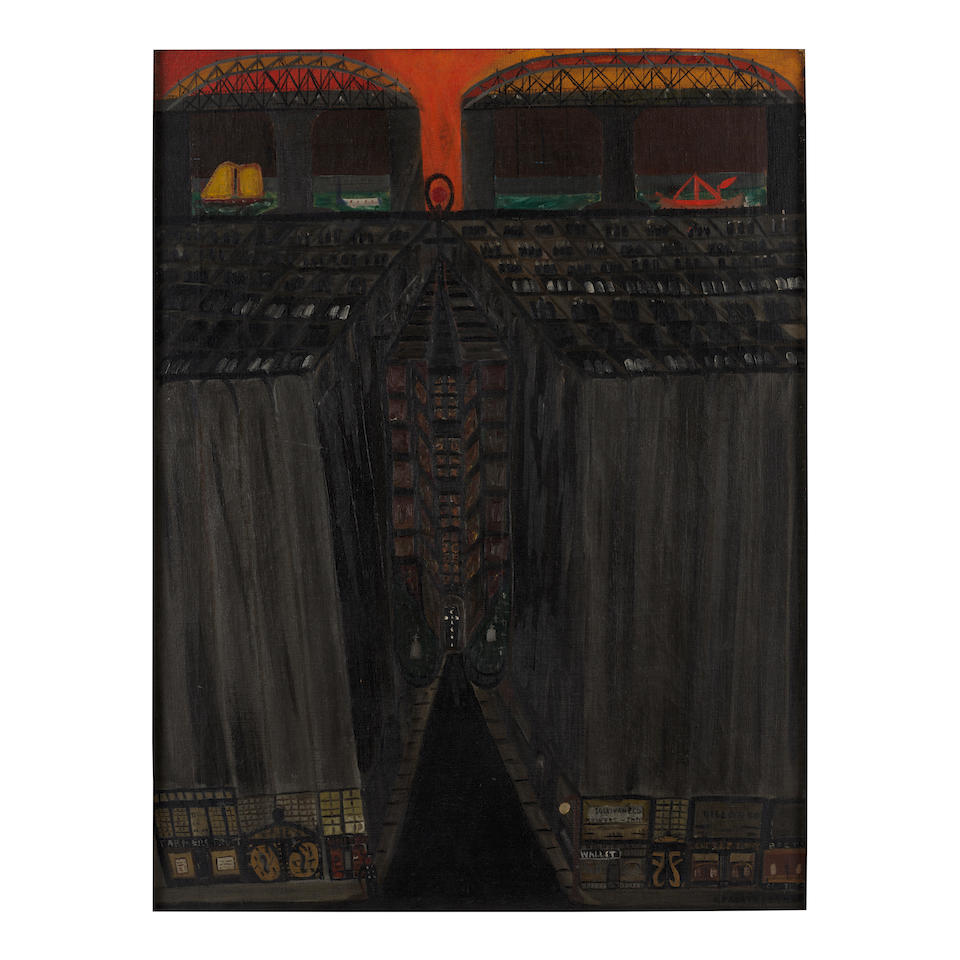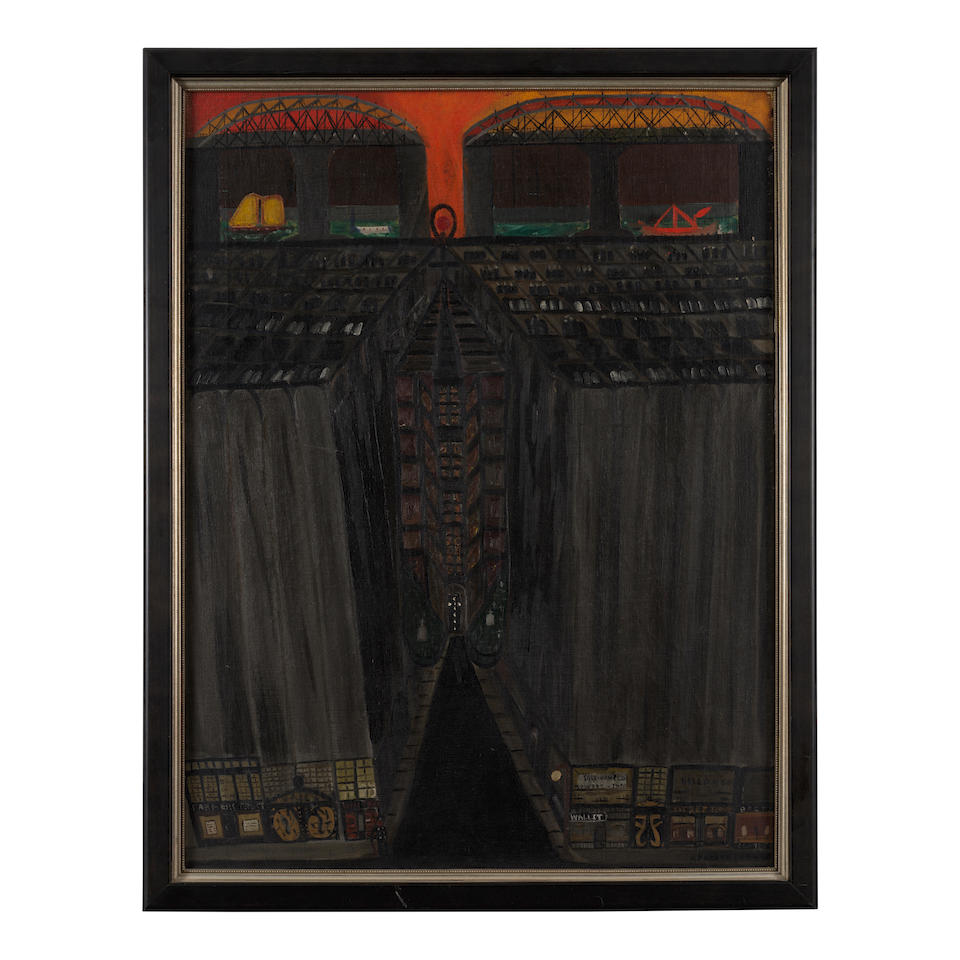269
Ralph Fasanella (1914-1997) Wall Street 29 1/4 x 22 in. (74.3 x 55.9 cm.) (Painted in 1946.)
Ralph Fasanella (1914-1997) Wall Street signed and dated 'R. FASANELLA 46' (lower right) oil on canvas 29 1/4 x 22 in. (74.3 x 55.9 cm.) Painted in 1946. Footnotes: Provenance Andrew Edlin Gallery, New York, by 2013. Acquired by the present owner from the above, June 18, 2013. Exhibited Ithaca, New York, Herbert F. Johnson Museum of Art, Cornell University, Urban Visions: The Paintings of Ralph Fasanella, September 11-November 10, 1985, n.p., no. 2, and elsewhere. Cooperstown, New York, Fenimore Art Museum, Ralph Fasanella's America, April 1-December 31, 2001, pp. 49-51, 176, illustrated, and elsewhere. New York, Andrew Edlin Gallery, Ralph Fasanella: A More Perfect Union, May 11-June 22, 2013, pp. 20-21, illustrated. Literature P. Watson, Fasanella's City, New York, 1973, pp. 40-41, illustrated. C. Moritz, ed., Current Biography Yearbook, New York, 1975, p. 123. S. Rodman, Artists in Tune with Their World: Masters of Popular Art in the Americas and Their Relation to the Folk Tradition, New York, 1982, pp. 95, 222, no. 29, illustrated. J. Rowe, 'Painting Ordinary Lives. Blue-collar Artist Ralph Fasanella Paints a World in Which a Sense of Community Matters,' The Christian Science Monitor, New York, February 15, 1989. S. Andrews, 'Down and Out On $350,000 a Year,' New York Magazine, February 13, 1995, vol. 28, no. 7, p. 70, illustrated. J. Zandy, Hands: Physical Labor, Class, and Cultural Work, New Jersey and London, 2004, p. 159. M. Fasanella, 'The Utopian Vision of an Immigrant's Son: the Oil on Canvas Legacy of Ralph Fasanella,' Italian Americana, Illinois, Summer 2010, vol. XXVIII, no. 2, p. 1, illustrated. (as Wallstreet) R. Smith, 'Ralph Fasanella: 'A More Perfect Union,' The New York Times, June 13, 2013. Ralph Fasanella was a working-class New Yorker and a celebrated figure in the American Social Realist movement of the 20th century, celebrated for his vibrant works that depict themes of everyday urban life in his native New York, labor struggles, and social justice. Fasanella began painting in the early 1940s, adopting a folk-art style formed around colorful and dense compositions. Painted in the early years of his artistic career, Wall Street would become one of Fasanella's first critiques on American capitalism and the harmful effects the system has on both individuals and communities. Paul S. D'Ambrosio poignantly wrote of the inspiration and significance of Wall Street in Fasanella's oeuvre, noting 'As a young boy of seven or eight years old, Fasanella often walked through the Wall Street neighborhood with his brother Tom when they played hooky from school. The aura of gloom and foreboding in this painting no doubt reflects not only the youngster's impressions of the cold, impersonal area but also both the vision of hell that reverberated from his Catholic upbringing and the mature Fasanella's opinions of the single-minded, antihumanistic pursuit of material wealth.' (P.S. D'Ambrosio, Ralph Fasanella's America, exhibition catalogue, Cooperstown, New York, 2001, p. 49) D'Ambrosio goes on to remark, 'Wall Street vividly expresses the spiritual emptiness and death that Fasanella equated with the loss of community and concern for one's fellow human beings. The streets are empty save for a lone policeman on a street corner, the buildings are gray and windowless, and the rooftops are covered with grim-looking figures marching as if in a funeral procession.' (P.S. D'Ambrosio, Ralph Fasanella's America, p. 49) In addition to the present work's significance in conveying the artist's burgeoning critiques of American capitalism, Wall Street also bears significance for it's compositional arrangement. D'Ambrosio remarks on this as well, noting that 'Wall Street marks the first appearance of a visual device for showing the mass and depth of urban buildings. Maintaining his elevated perspective, Fasanella depicts the buildings as a massive block with a large cleft in the center. This compositional framework not only gives the viewer visual access to everything from storefront to rooftop, but also provides a niche at the center of the canvas toward which the eye is unmistakably drawn.' (P.S. D'Ambrosio, Ralph Fasanella's America, p. 50) Fasanella would employ this visual device frequently when designing his compositions and is considered a distinctive quality of his artistic style. For further information on this lot please visit Bonhams.com For further information about this lot please visit the lot listing
Ralph Fasanella (1914-1997) Wall Street signed and dated 'R. FASANELLA 46' (lower right) oil on canvas 29 1/4 x 22 in. (74.3 x 55.9 cm.) Painted in 1946. Footnotes: Provenance Andrew Edlin Gallery, New York, by 2013. Acquired by the present owner from the above, June 18, 2013. Exhibited Ithaca, New York, Herbert F. Johnson Museum of Art, Cornell University, Urban Visions: The Paintings of Ralph Fasanella, September 11-November 10, 1985, n.p., no. 2, and elsewhere. Cooperstown, New York, Fenimore Art Museum, Ralph Fasanella's America, April 1-December 31, 2001, pp. 49-51, 176, illustrated, and elsewhere. New York, Andrew Edlin Gallery, Ralph Fasanella: A More Perfect Union, May 11-June 22, 2013, pp. 20-21, illustrated. Literature P. Watson, Fasanella's City, New York, 1973, pp. 40-41, illustrated. C. Moritz, ed., Current Biography Yearbook, New York, 1975, p. 123. S. Rodman, Artists in Tune with Their World: Masters of Popular Art in the Americas and Their Relation to the Folk Tradition, New York, 1982, pp. 95, 222, no. 29, illustrated. J. Rowe, 'Painting Ordinary Lives. Blue-collar Artist Ralph Fasanella Paints a World in Which a Sense of Community Matters,' The Christian Science Monitor, New York, February 15, 1989. S. Andrews, 'Down and Out On $350,000 a Year,' New York Magazine, February 13, 1995, vol. 28, no. 7, p. 70, illustrated. J. Zandy, Hands: Physical Labor, Class, and Cultural Work, New Jersey and London, 2004, p. 159. M. Fasanella, 'The Utopian Vision of an Immigrant's Son: the Oil on Canvas Legacy of Ralph Fasanella,' Italian Americana, Illinois, Summer 2010, vol. XXVIII, no. 2, p. 1, illustrated. (as Wallstreet) R. Smith, 'Ralph Fasanella: 'A More Perfect Union,' The New York Times, June 13, 2013. Ralph Fasanella was a working-class New Yorker and a celebrated figure in the American Social Realist movement of the 20th century, celebrated for his vibrant works that depict themes of everyday urban life in his native New York, labor struggles, and social justice. Fasanella began painting in the early 1940s, adopting a folk-art style formed around colorful and dense compositions. Painted in the early years of his artistic career, Wall Street would become one of Fasanella's first critiques on American capitalism and the harmful effects the system has on both individuals and communities. Paul S. D'Ambrosio poignantly wrote of the inspiration and significance of Wall Street in Fasanella's oeuvre, noting 'As a young boy of seven or eight years old, Fasanella often walked through the Wall Street neighborhood with his brother Tom when they played hooky from school. The aura of gloom and foreboding in this painting no doubt reflects not only the youngster's impressions of the cold, impersonal area but also both the vision of hell that reverberated from his Catholic upbringing and the mature Fasanella's opinions of the single-minded, antihumanistic pursuit of material wealth.' (P.S. D'Ambrosio, Ralph Fasanella's America, exhibition catalogue, Cooperstown, New York, 2001, p. 49) D'Ambrosio goes on to remark, 'Wall Street vividly expresses the spiritual emptiness and death that Fasanella equated with the loss of community and concern for one's fellow human beings. The streets are empty save for a lone policeman on a street corner, the buildings are gray and windowless, and the rooftops are covered with grim-looking figures marching as if in a funeral procession.' (P.S. D'Ambrosio, Ralph Fasanella's America, p. 49) In addition to the present work's significance in conveying the artist's burgeoning critiques of American capitalism, Wall Street also bears significance for it's compositional arrangement. D'Ambrosio remarks on this as well, noting that 'Wall Street marks the first appearance of a visual device for showing the mass and depth of urban buildings. Maintaining his elevated perspective, Fasanella depicts the buildings as a massive block with a large cleft in the center. This compositional framework not only gives the viewer visual access to everything from storefront to rooftop, but also provides a niche at the center of the canvas toward which the eye is unmistakably drawn.' (P.S. D'Ambrosio, Ralph Fasanella's America, p. 50) Fasanella would employ this visual device frequently when designing his compositions and is considered a distinctive quality of his artistic style. For further information on this lot please visit Bonhams.com For further information about this lot please visit the lot listing
American Art Online
Ends from
Venue Address
Important Information
Terms & Conditions
Buyers' Obligations
ALL BIDDERS MUST AGREE THAT THEY HAVE READ AND UNDERSTOOD BONHAMS' CONDITIONS OF SALE AND AGREE TO BE BOUND BY THEM, AND AGREE TO PAY THE BUYER'S PREMIUM AND ANY OTHER CHARGES MENTIONED IN THE NOTICE TO BIDDERS. THIS AFFECTS THE BIDDERS LEGAL RIGHTS.
If you have any questions about the Conditions of Sale, please contact your nearest client services team.
From 28 June 2025, the import into the EU of non-EU property of a certain age (and in some categories above a certain value) is subject to additional requirements. Under the relevant EU Regulation, it is the Buyer's sole responsibility to assess whether any Lot meets the criteria for import into the EU. The refusal of any required Import Licence or Importer Statement, or any delay in obtaining such Licence or Statement shall not give rise to the rescission or cancellation of any Sale, nor allow any delay in making full payment for the Lot.
Buyers' Premium and Charges
For all Sales categories excluding Arms & Armour, Coins and Medals, Motor Cars, Motorcycles, Wine & Whisky
28% on the first $50,000 of the hammer price;
27% of the hammer price of amounts in excess of $50,000 up to and including $1,000,000;
21% of the hammer price of amounts in excess of $1,000,000 up to and including $6,000,000;
and 14.5% of the hammer price of any amounts in excess of $6,000,000.
A 3rd-party bidding platform fee (the "3rd-party bidding platform fee") equal to 4% of THE BID PRICE shall be payable by buyers whose successful bid is submitted via 3rd-party bidding platforms, including Invaluable; Live Auctioneers; The Saleroom; Lot-tissimo.
Payment Notices
Payment for purchases may be made in or by (a) cash, (b) cashier's check or money order, (c) personal check with approved credit drawn on a U.S. bank, (d) wire transfer or other immediate bank transfer, or (e) Visa, MasterCard, American Express or Discover credit, charge or debit card for returning clients only. Please note that the amount of cash notes and cash equivalents that can be accepted from a given purchaser may be limited.
Shipping Notices
Los Angeles & New York Auctions
If you have requested a shipping quote, we will send this to you via email within 5 business days of the auction ending.
Please note our shipping quotes are bespoke and require special care and handling from our team and shippers. Shipping will be booked after payment is received. Please allow 7-14 business days from the time of booking for packing and dispatch, depending on your chosen shipping method. If your purchase is time sensitive, or you wish to explore other options, please see our list of alternative third party shippers in New York and Los Angeles who may be able to assist you.
Oversized Lots
Please note that all lots marked with a W in the catalog are oversized and subject to additional storage and shipping methods. All additional lots purchased with W lots are considered group lots and will be subject to the same terms as W lots.
W Lots will be transferred to offsite storage at DTD Fine Art Services at the buyer's risk and expense within five (5) business days following the auction. Please contact the Client Services team at bids.us@bonhams.com for the exact movement date.
The per-lot charges levied by DTD Fine Art Services are as follows (plus any applicable sales tax):
FURNITURE/LARGE OBJECTS
Transfer .................. $75
Daily storage........... $10
Insurance (on Hammer + Premium + tax) 0.3%
SMALL OBJECTS
Transfer ................. $37.50
Daily storage........... $5
Insurance (on Hammer + Premium + tax) 0.3%
Please note property is also subject to a Cross Dock Release Fee ($25 for Smalls and $45 for Furniture and Large Objects) & if charges are paid with a credit card, Door to Door Fine Art Services will charge a 3% Convenience Fee.
If you have any questions, please contact our Client Services team.
Boston & Marlborough Auctions
Please click HERE for detailed collection and shipping information for Boston and Marlborough auctions.









